Every ten years or so you might notice an abundance of tent caterpillar nests like the one pictured above. The eastern half of the U.S and Canada get hit hard, but I’m sure our readers along the pacific coast and in the U.K. can relate to this as well.
Eastern tent caterpillars overwinter in a black, styrofoamy egg mass and hatch in the early spring by the hundreds. They build a silky web-like tent in the fork of a tree branch to shelter them at night and during rain. They live as one great big family inside the nest at night.
They leave each day in search of tender spring foliage and use a silk and pheromone trail to find their way back to the web at night.
Apple and cherry trees are a favorite. Around here, it’s pretty common to see long stretches of webs along the wild cherry trees and crab apple trees that line the highway. They don’t seem to like red maples, sycamores, or conifers much.
The Eastern Tent Caterpillar is easily identified outside of its tent by the solid yellow stripe down its back. Their cousins, the Forest Tent Caterpillar look very similar but do not make a webby nest. They like to hang out in large groups and can be identified by the broken, spotty stripe down their backs.
There is also a Western Tent Caterpillar. These fuzzy tent builders have a checkered yellow pattern down their back.
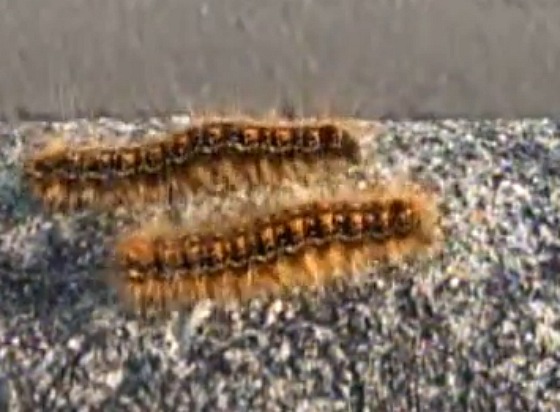
You’ll see tent caterpillars about the time that new spring leaves start to uncurl. They hang around for about 6 weeks, fatten up on leaves then crawl off to find a safe place to spin a cocoon.
Caterpillars will defoliate trees fairly quickly but rarely do any permanent damage. When the tree loses its leaves, its growth might slow a little or it might become slightly less resistant to disease. For an otherwise healthy tree, this won’t be an issue. There is little reason to worry about tent caterpillar control.
As nature would have it, the average tree can tolerate 2-3 consecutive years of defoliation. Tent Caterpillar populations tend to rise for 2-3 years then naturally decline. The caterpillars are native to our area. They are part of our ecosystem and they rise and decline on a ten-year cycle. They are a natural occurrence and for most of us, there is no need for tent caterpillar control…unless you have horses.
In 2001, farms in Kentucky, Ohio, Indiana, and Illinois reported a record number of miscarriages and stillbirths in horses. After ruling out a bunch of factors, it was discovered that the Eastern Tent Caterpillar is linked to Mare Reproductive Loss Syndrome. I’m no veterinarian, but from what I gather when the horses eat the caterpillars the prickly hair stick inside the horse’s digestive track and cause a whole mess of trouble in pregnant mares. Caterpillars sometimes mistake fence posts for tree trunks- making them readily available for snacking.
If you can find the egg mass, removing it before it hatches is a good way to prevent tent caterpillars on your tree. There are sprays available as well. The “old school” way of dealing with tent caterpillars is to burn the nest. This often causes a lot more damage to the tree (and your eyebrows) than the caterpillars would have inflicted.
If you are noticing webs in the late summer or early fall, you are probably seeing webworms. Webworms look similar to tent caterpillars except there are no distinct lines or patterns running down their backs. Their pattern runs along their side.
Fall Webworms build their tent on the tips of a tree branch. (Tent caterpillars build their nests toward the center of the tree in forked branches.) Fall Webworms do not generally leave their tent. The feed inside their tent where they are protected from predators. Once they defoliate one area, they build their tent over another.
As with tent caterpillars, webworm damage is primarily cosmetic. The easiest way to remove a web worm nest, is to clip and dispose of the affected branch. You can also break open the web, making the webworms more accessible to birds or other insects that will eat them.
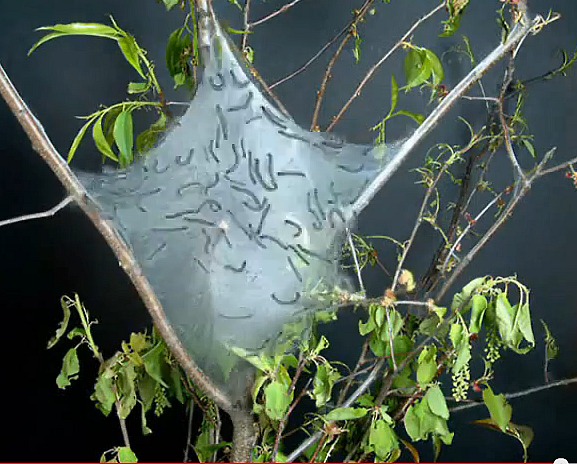

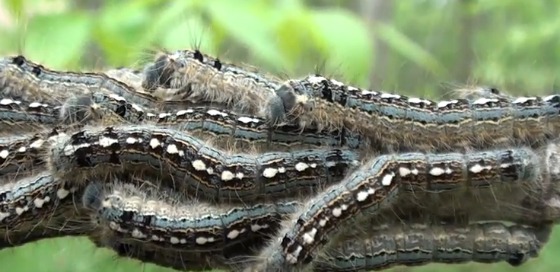
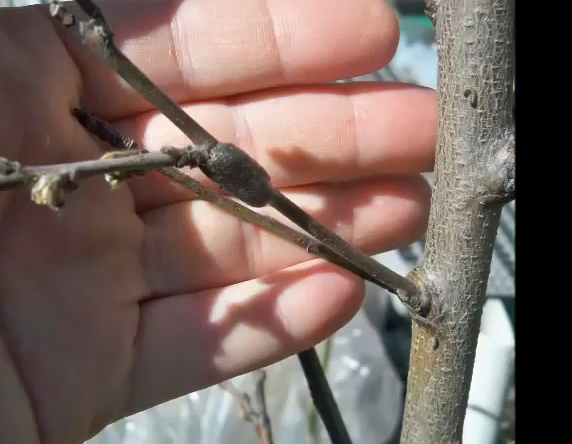

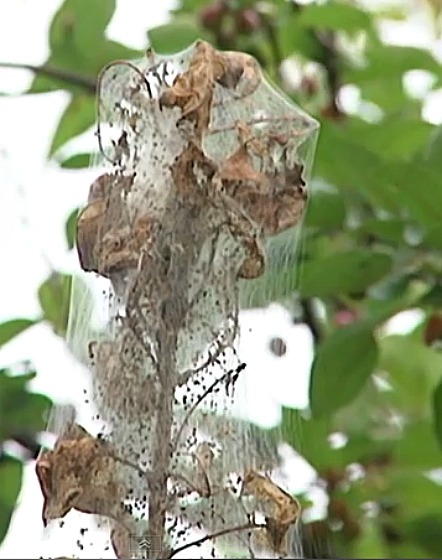
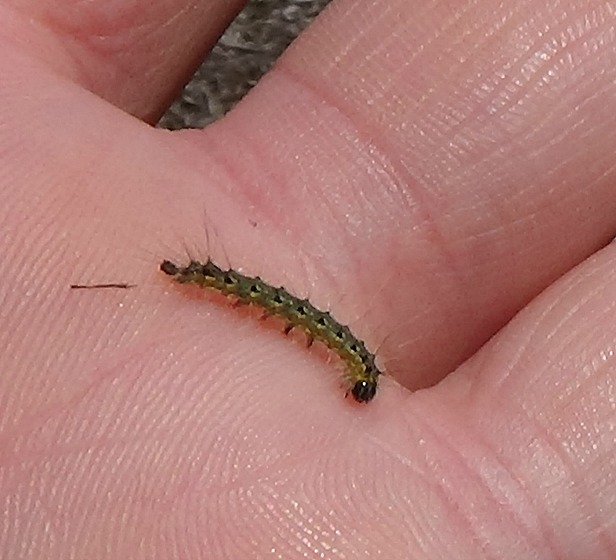
This is totally off the subject, but I was wondering if there is anyway one can plant hostas,and other shade plants under evergreen trees. My big ash tree that was a great place for the shad plants, died and the only trees I have left are the evergreens?
Monica,
I don’t see why not as long as there’s good soil and the plants receive some sunlight.
Here in Texas, I put out Trichogramma Wasps cards which you hang from the tree branches in a series of release,. early in the spring, These little wasps go after the larvae & are miracle workers. Beneficial insects are better than chemicals.
Do they wok on white moths ? My greens in the garden are look like Swiss cheese . Someone told me it’s from their larvae?
About 20 years ago the web worms came through and I sprayed our trees with Orange TKO and killed them. It’s not poison so it’s safe.
All my life i have seen these caterpillars around my backyard and have always noticed how beautiful they are. I just caught one and am trying to raise it. Thank you for making this website, it was very informative.
Im not sure if its too late to ask a question, but my 1 year old 6ft. Eastern redbud (Long Island NY) was infested with webworms late last summer & early fall.
I sprayed with something I got off Amazon, opened the webs and hung a birdfeeder on the lower branch to attract predators.
The problem is it’s spring and I have NO new growth. Not a bud in sight. Did they kill the tree or could it be in shock?
Any advice would be welcome….I love this tree.
Lisa,
Seems too early for redbuds to be doing much of anything. Wait until mid May before you panic. This is how you test to see if a plant, or a branch on a plant has died. Just scratch the bark of your plants with your finger nail. If the tissue below the bark is green and firm your plants are fine. If the tissue is brown and mushy that part of the plant is dead.
They are horrid. I live in north-east Alberta and they devour everything including Aspens, cherries and berry trees.. They were so bad that they covered everything onto our home and barns. the ground moved everything
into our yard. Our children would not go out side and couldn’t sleep do to the constantly munching. In the end the county Sprayed them with Sevin. They finally died and we were left using scoop shovels of the caterpillars into several pickup trucks full to be destroyed.. As saying the trees will have a chance tp regrow……I don’t think so. Our old trees also died..
Thank you for the article on tent catipillars and the webworms. We are driving through the Columbia gorge and wondered what was on the trees. I thought they were tent catipillars but they are webworms that I never heard of before.
Has anyone had success using some kind of diy solution with a powerwasher to reach tentworms in webs that are in really high trees over 40 feet? Suggestions welcomed!
Candace,
Seems like a good idea to me.
Here is a quick and easy way to get rid of tent catapillers before they get out of their web nest and not have to spray the entire tree or bush. This is cost effective for a few affected plants and assumes you do not have 100 acres but are using a limited area.
Household cockroach & ant spray can is effective. Just spray the web while the catapillers are still in it.
Prevents further damage to the plant and diminishes the next generation of pests from being created.
Anyway this works for me. I also use it on fire ant hills.
Thanks Bernie, makes sense.
I’ve had good success with this method too, assuming the webs were within reach of the spray.
Toxic sprays like this not only kill the caterpillars but the birds that eat them; the bees that are nearby. Why destroy so many when there are non toxic methods?
Thanks for the info about Tent Caterpillars and Web Worms. I had to sign up for your website when I read in a comment that you prefer Coronas to Felco pruners. I also prefer Coronos. I’ve still got my first pair of 1/2 inch bypass cutters and my wood handled lopers and they are both 35 years old. Love them!
Laurie,
You have good taste in pruning shears!
I gave my web worms a shot of starting fluid and they are dead, dead, dead. It doesn’t seem to hurt the tree either.
Mike, I found a good way to get rid of tent caterpillars a few years ago when they were feasting on a beautiful small tree in my yard. Find the “tent”, wait until evening, when the caterpillars return to the nest and spray just the nest with wasp and hornet killer. (the kind that sprays 20 to 25 feet) Just an F.Y.I. for anyone that wants to get rid of them. Also,Thanks, for all the info and advice that you pass along to all of us.
Hi Mike.
There is a product I use that chases all kinds of insects away. It’s made by BAYER (the aspirin people), and was originally invented (I believe) for orchard use. Instead of spraying down the apple, peach, etc. trees with insecticides, you just sprinkle a measured amount of these granules around the base of the tree, and you’re done. These granules come in different varieties for tree & bush, vegetable garden, etc.. The package label recommends that you repeat this process yearly but, I’ve found for my ornamental trees that, I have only needed to re-apply every 3 years. This product can be purchased at any garden center or big-box store. I don’t know about it’s chemical content but, I do know that it has made my life a lot easier.
Can you name the Bayer product? I would like to purchase some, thanks, Bob
Bob,
Bayer only has a few liquid insecticides, just fine the one that is rated for the pest you are trying to control. I don’t know what they call it.
I have used this product for beetle control on my knockout roses. It really works well. I discontinued use though because I was concerned about harming honeybees.
Bayer Tree and Shrub 12 month protection has been effective for me. I have the liquid form which takes care of ornamental tree pests from Japanese Beetles, bag worms, borers and basically all other insect issues. It is mixed in a bucket and dumped around the soil and works systemically.
It can work within a week for small trees but for larger trees it can take months to work it’s way up the tree.
As mentioned by Marlene I don’t need to use it every year. I can wait several years before the offending insects return.
It saved several of my mesquite trees with severe borer damage.
It is not to be used on any food crop trees.
For bag worms or Japanese be sure to apply late winter or very early in spring giving the systemic action time to get to the top of the tree. If you see the activity it is too late and must apply sprayed insecticide immediately.
It’s expensive, many garden center like at Walmart will have deep end of season discounts on garden insecticides when closing out and getting ready for Christmas, at that time I will stock up for the next year.
Here at the Hartman Arboretum, we cut out the web and burn it. A question about the clam propagation technique?? How long does it take to form roots and after roots are observed how long before potting up or planting out?? The Master Gardeners have propagation units on a Redbud, Blueberry and Button Bush. Thoughts?? Grant Hartman
Hi Grant,
The clam shell air propagator is a lot of fun to use, but its not the most efficient method of propagation. In some cases it can take 2-3 months for some trees to develop a large enough root system to be removed from the parent tree.
I use the direct approach. I spray the ‘nest’ with Malathion.
Howard
Thank you so much for a terrific article! I really enjoy your newsletters and all the tps that help us take better care of our woodlot.
Mike, we are having a huge problem with bag worms (?) on our Leyland Cypress trees. We have already lost one in the row and are battling to keep the others. We have continually treated with Sevin but it doesn’t seem to be effective; or at least, we don’t think that it is. Maybe it’s just keeping them at bay. We realize the Sevin has to make contact with the worm. Do you have any suggestions when the best time the worm will leave the bag to feed on the foliage?
These worms…Catapillars….can be easily destroyed………heres what I do……..get a bag of diatamacious earth……put a couple of tablespoons in a sprayer attach the hose and spray the tree, web, and the ground around the tree ….presto….problem GONE………
Susan
Thanks Susan,
Bag worms encase themselves with foliage they strip from the tree. They hang from the branch and look like triangular cones and if you try to tear the cones apart with your fingers, it’s almost impossible because the casing is so tough. If you sit and watch the cone, it will move because the worm is moving inside. The casing will get larger as time goes on and as the worm eats more of the tree’s foliage thus, killing your tree. If what you spray does not make contact with the worm, it will not kill the worm. So my question to Mike is this…do you know if there is a certain time of day the worms come out of their casings to eat the foliage or is it just random times? Or, is there anything we can spray that will penetrate the casing of a “bag” worm??
More here from Ohio State http://backtree.com/pdf/Bagworm%20And%20Its%20Control.pdf
Mike – I live in northern Michigan and years ago this was an annual problem. When we first noticed the caterpillars we would wrap duct tape around the tree trunk about 12 to `18 inches up from the ground. After doing so, we would ply the duct tape with Vaseline or some kind of heavy grease, not oil, to keep them from crawling up. Then we sprayed the tree branches that had them on it before the nests started to form,
I AM A RECENT SUBSCRIBER AND AM REALLY ENJOYING YOUR POSTINGS. I MUST SAY I WAS A BIT SHOCKED WHEN I READ YOUR FAVORITE PRUNING SHEARS ARE CARONAS AND NOT FELCO. HAVE YOU OWNED A PAIR OF FELCOS? THANKS TOM
Mike..also enjoyed the ‘Pruning Video’ ! ‘How to Trim Japanese Maples’. All that pruning you did..would you ‘make cuttings’ from what you took off also ? Extra Work=Extra Plants, no ?
Hi Jerry,
Japanese maples are usually grown from seed or grafted. They don’t do well propagated as cuttings.
For other plants, yes. We use our cuttings to fill our mist bed.
Thank you for this article. Although I kind of enjoyed the lighter fluid method, being able to identify the eggs, makes for a more practical solution. Especially since drought conditions sometime go along with the time of year the nests are visible here.